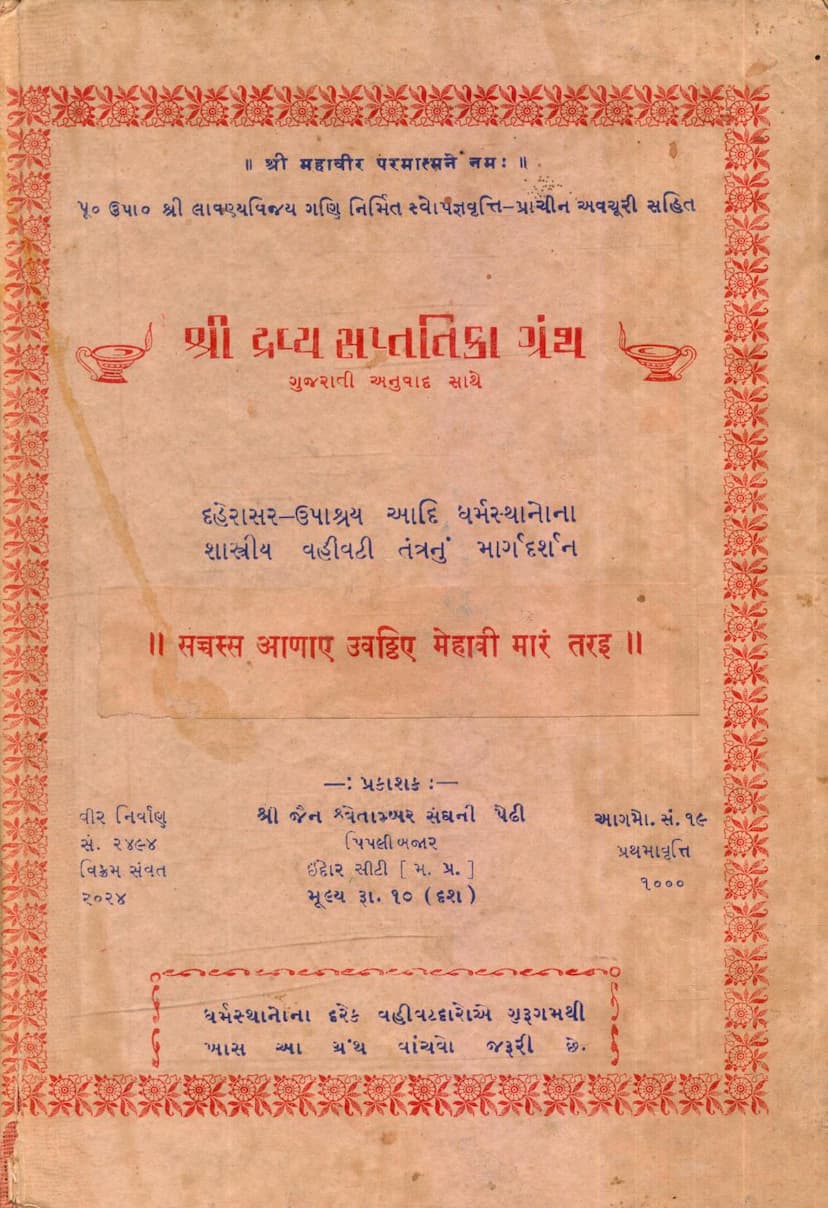Dravya Saptatika Granth
Added to library: September 1, 2025

Summary
Based on the provided Jain text, particularly the "Dravya Saptatika Granth" by Lavanyavijay Gani and Nirupamsagar, here's a comprehensive summary in English:
Book Title: Dravya Saptatika Granth (also referred to as Dravya Sittari)
Authors: Lavanyavijay Gani, Nirupamsagar
Publisher: Shri Jain Shwetambar Sangh Pedhi, Pipli Bazar, Indore City (Madhya Pradesh)
Overall Purpose and Context:
The "Dravya Saptatika Granth" is a significant Jain text that provides a comprehensive, classical, and authoritative guide for the administrative and financial management of Jain religious institutions (Derasar, Upashray, etc.). It emphasizes the scientific and scriptural basis for managing religious properties and assets, often referred to as "Dravya" or "Dharma Dravya" (religious wealth). The book was published in Vir Samvat 2494 / Vikram Samvat 2024, indicating its relevance during that period and aiming to guide the management of religious trusts and assets in line with Jain principles. The text highlights the crucial responsibilities of the Jain Sangh (community) in acquiring, safeguarding, managing, and utilizing religious wealth for the upliftment of souls and the proper functioning of the Jain Shasan (dispensation).
Key Themes and Content:
The book delves into the intricacies of managing Jain religious wealth, emphasizing a systematic and scriptural approach. The summary of its content can be understood through its structure and core messages:
-
Dravya (Wealth) and its Classification:
- The text meticulously defines and classifies various types of religious wealth ("Dravya"). It distinguishes between "Dev Dravya" (wealth dedicated to the deity), "Guru Dravya" (wealth dedicated to the monastic preceptors), "Gyan Dravya" (wealth for the dissemination of knowledge), "Sadharan Dravya" (common wealth for the use of the entire Jain community), and "Dharma Dravya" (wealth for general religious purposes).
- It provides detailed explanations of how these categories are established, what constitutes them, and crucially, when they cease to be considered such (e.g., if a deity's idol is lost or a monastery is destroyed).
-
The Seven Doors (Dwar) of Dravya Management: The core of the book is structured around seven essential "doors" or aspects of managing religious wealth:
- Bhed Dwar (Classification of Wealth): This section categorizes wealth into different types and sub-types, as mentioned above.
- Vriddhi Dwar (Growth of Wealth): This focuses on methods for increasing religious assets, emphasizing legal and ethical means. It also outlines the qualifications of those responsible for managing and growing this wealth, highlighting the importance of integrity, knowledge of scriptures, and devotion.
- Nash Dwar (Destruction/Loss of Wealth): This section details the various ways religious wealth can be lost or destroyed. It covers actions like misappropriation, neglect, misuse, fraud, and the consequences of such actions, emphasizing the scriptural prohibitions and penalties.
- Gun Dwar (Merits/Benefits): This door highlights the virtuous outcomes and spiritual benefits that accrue to those who manage religious wealth with integrity and dedication. It discusses both worldly advantages and the ultimate spiritual liberation.
- Dosh Dwar (Faults/Demerits): This section elaborates on the faults and sinful actions associated with the mismanagement or misuse of religious wealth, detailing the negative consequences and karmic repercussions. It warns against various forms of transgressions.
- Prayashchit Dwar (Penance/Expiation): This crucial door outlines the procedures and principles of atonement and purification for any unintentional or intentional errors in the management of religious wealth, emphasizing the importance of confession and rectifying mistakes.
- Drishtant Dwar (Illustrative Examples): This section provides numerous narratives and examples from Jain scriptures and history to illustrate the principles discussed in the preceding doors, making the teachings more accessible and impactful.
-
Emphasis on Divine Order and Ethics:
- The text strongly advocates for adherence to the "Agya" (divine command or scriptural injunction) of the Jain Tirthankaras and the tradition of the Sangh.
- It stresses that all actions related to religious wealth must be performed with "Vivek" (wisdom, discretion) and according to prescribed "Vidhi" (procedures).
- It critiques external interference in religious affairs, particularly highlighting concerns about secular laws like the Public Trust Act potentially undermining the traditional management by the Jain Sangh, and the potential for misappropriation of funds for non-religious purposes.
-
The Role of the Sangh and its Members:
- The book underscores the responsibility of the entire Jain community ("Sangh") and its administrative bodies in upholding the sanctity and proper management of religious assets.
- It calls for vigilance and dedication from trustees, administrators, and community members to protect and enhance these assets for their intended purpose.
-
Dravya as a Means to Spiritual Upliftment:
- The text positions the careful and righteous management of religious wealth not merely as an administrative task but as a spiritual practice. It is seen as a way to accumulate merit, develop virtuous qualities, and ultimately aid in the path to spiritual liberation ("Moksha"). Mismanagement, conversely, leads to spiritual downfall.
Significance and Impact:
The "Dravya Saptatika Granth" serves as a foundational text for understanding the financial governance and ethical stewardship within Jainism. It provides a framework for preserving the integrity of religious institutions and ensuring that their resources are utilized for the true welfare of the community and the propagation of Jain teachings. Its re-publication with Gujarati translation and commentary aimed to make these vital principles accessible to a wider audience, emphasizing the ongoing need for adherence to these scriptural guidelines, especially in the face of changing societal and legal landscapes. The book's emphasis on "Guru-gam" (guidance from enlightened preceptors) highlights the importance of seeking spiritual direction in all aspects of life, including the management of religious wealth.